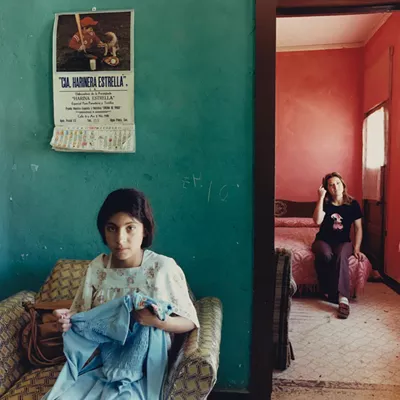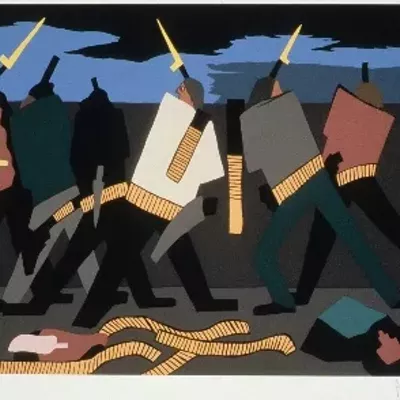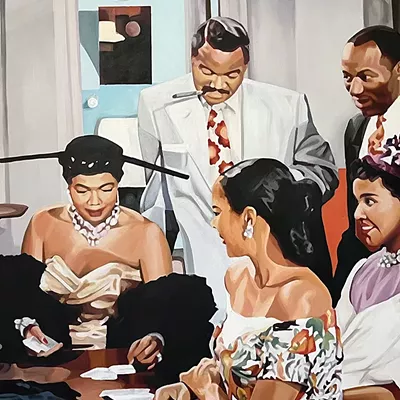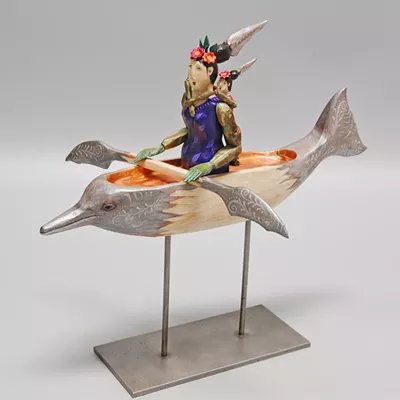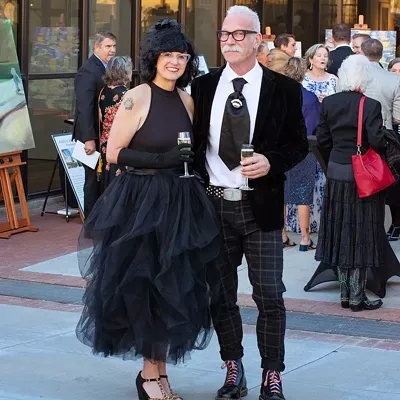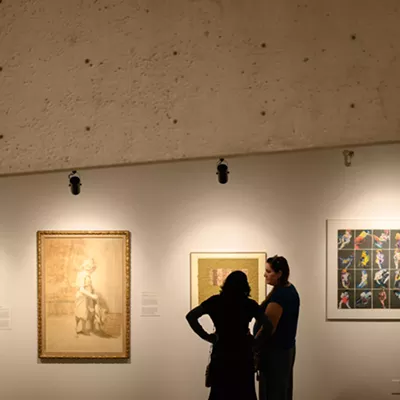A striking statue of a dying horseman, crafted in fiberglass by the late, acclaimed Luis Jimenez, has long languished in a distant downstairs gallery in the Tucson Museum of Art.
Made of the same brilliant fiberglass used in lowrider cars, Jimenez's "End of the Trail with Electric Sunset" has a Native American warrior slumping forward on his life-sized steed. And like those lowriders, the sculpture is ablaze with light: The horse's eyes glow an electric red and the fiberglass sunset below him shines an incandescent orange.
For years, the glittering artwork, a prized piece by a significant Mexican-American artist, was not exactly shown to best effect in the museum's landlocked downstairs corridor. Now the horse and rider have ridden on up to a place of glory.
They're in a big new glass window right by the TMA's front door, as visible to passersbys as mannequins in a shop window. And just to make sure that no one misses the piece, the horse's electric eyes shine all night long.
The big move "End of the Trail" made to a highly-visible location is just one of many salutary improvements at the museum, which reopened last weekend after a renovation at least a year in the planning and four months in the making.
"This is our first renovation in over 15 years," director Jeremy Mikolajczak said on a tour last week. "We're adapting to unique architecture. With the descending spiral, this is Tucson's own Guggenheim."
The 1974 building, designed by architect William Wilde, was overhauled by Andy Anderson "from top to bottom. The curatorial team looked at everything, from the Pre-Columbian work on up. Everything on this campus has been touched."
At a cost of $750,000, all of it contributed it by private donors, the museum has expanded its gallery space, adding 5,000 square feet for a new total of 30,000. It's installed a handsome wood floor, removed some walls to create a feeling of openness and replaced the old air-conditioning system.
The new gallery was carved out of the old museum shop off the lobby; the store has been moved to the Fish House, one of five historic houses the museum cares for on behalf of the city. (The creative space for kids has also migrated to the Fish.) With the new gallery, the main floor will be dedicated entirely to temporary exhibitions.
The gallery's inaugural show, Dress Matters: Clothing as Metaphor, looks at contemporary artists who use clothes to investigate "gender, age, ethnicity [and] history," said chief curator Julie Sasse. A second temporary show, in an older gallery, Desert Dweller, features an array of real dresses created by Tucson designers in the mid-20th century and beyond.
Most importantly though, the overhaul has brought prized holdings in the permanent collections out of the shadows and into the light. If "End of the Trail" has won greater visibility, other significant works by renowned artists have been hauled out of storage and put on view.
Any day of the week, Tucsonans and tourists can now stop in and see the work of such world-renowned artists as Goya, Hogarth, Rodin, Renoir, Toulouse-Lautrec and Jasper Johns. And they can get a gander at art by locals with national reputations, including Nancy Tokar Miller, Barbara Rogers, Jim Waid and Bailey Doogan.
The curatorial team did a deep re-thinking of how the museum's own collections should be displayed, Mikolajczak said. Now "15 specific galleries" exhibit works from the permanent collection, organized by genre or geography or style or tie period. This art will stay on the walls three years before being rotated out, he said, an innovation that will help local teachers create long-term lesson plans.
The new gallery of European art, albeit tiny, contains such treasures as six late 18th-century etchings by the great Spaniard Goya, and an excellent 1895 Toulouse-Lautrec litho. A bevy of Rodins and at least one Renoir grace The Well, a lower-level space filled with long-term loans from the Kasser Mochary Foundation.
A permanent gallery of 20th-century modern art highlights Marsden Hartley and Jacques Lipchitz. A works-on-paper section on the lower ramp features feminist artist Miriam Shapiro, Chuck Close, and Ed Ruscha. "Farm Ghosts," a large painted woodcut by leading feminist artist Harmony Hammond, haunts the large contemporary gallery.
For the first time in this photography-mad town, the museum now has a dedicated photo gallery with, among other delights, a gleaming blue-painted bird by Kate Breakey from her acclaimed Small Deaths series.
A small but beautiful Asian ceramics gallery proudly displays a blue-and-white bowl from China's Yuan Dynasty (1280-1836), a pot that curator Christine Brindza describes as the museum's "pièce de resistance."
The excellent Pre-Columbian collection has a new installation, and the rest of the museum's strong Latin American holdings have been divided between a second floor space devoted to colonial art—a sumptuous painted wooden sculpture of the Virgin Mary is a stand-out—while the Mexican folk art now has its own bright space downstairs.
The Art of the American West has transferred out of the Fish House and back into the main building. Traditional "cowboy" landscapes and portraits are interspersed with contemporary interpretations like William "Billy" Schenck's big pop-art oil, "Wyoming #44." Bridging the two camps are three Maynard Dixon oils, beautifully picturing the land in simplified shapes.
Brindza's thoughtful installation of Native American art pairs a Fritz Scholder contemporary Indian portrait in blazing red with a 19th-century Navajo chief's blanket; its bold stripes, in black and red, echo Scholder's colors.
A space devoted to contemporary artists of the Southwest, curated by Sasse, features Tucson favorites whose interests range from abstraction to feminism, including Bailey Doogan, whose self-portrait "Southwest Chin-Up" continues her exploration of female bodies and aging.
"You can see in one place artists who work in this area," Sasse said. "Just because you live here doesn't mean you're not an artist of the world."

